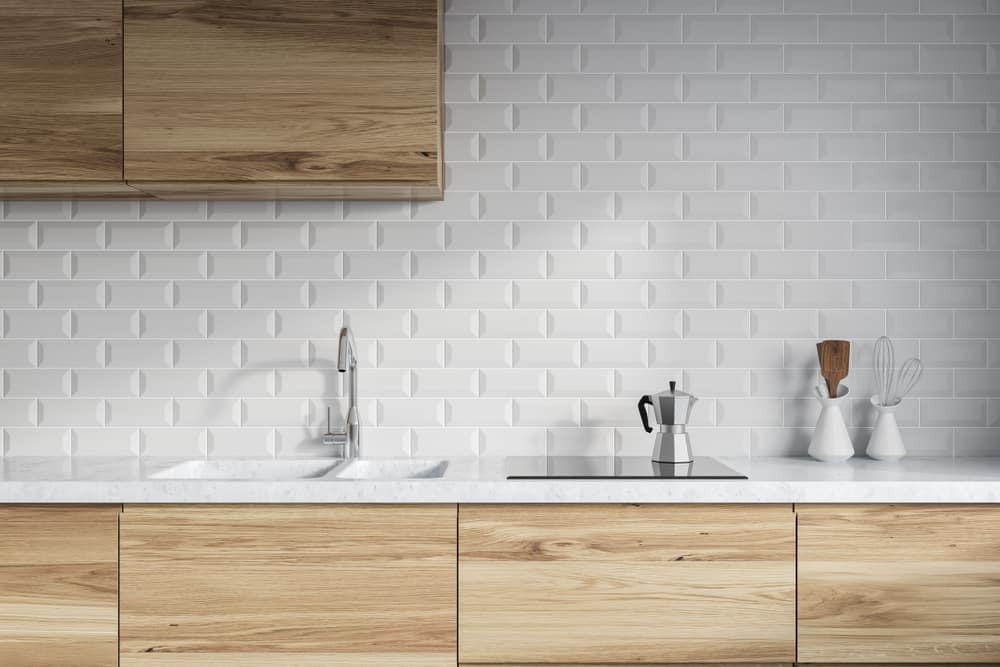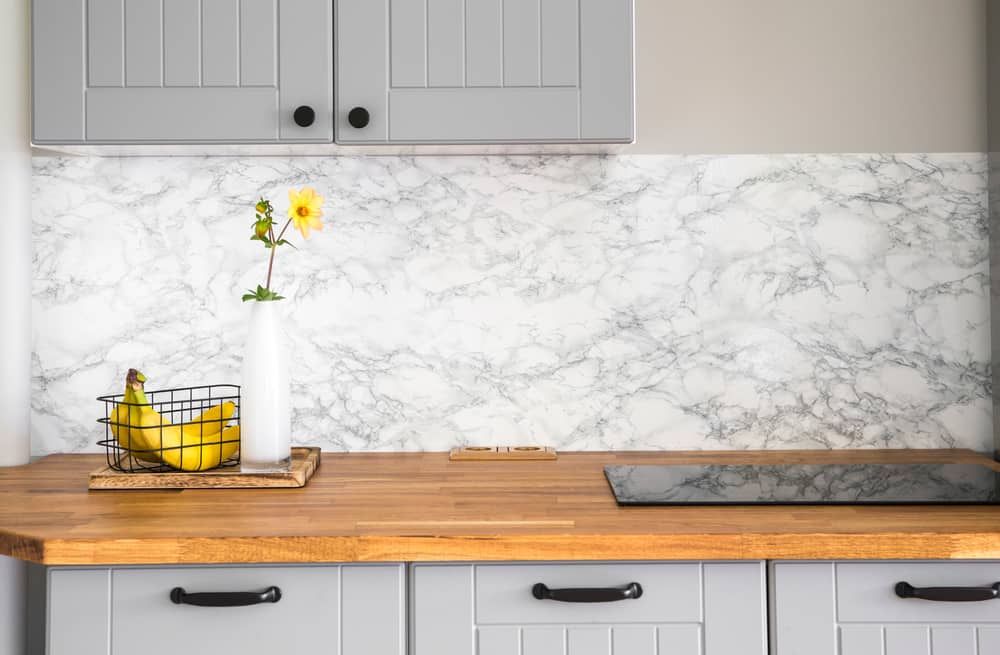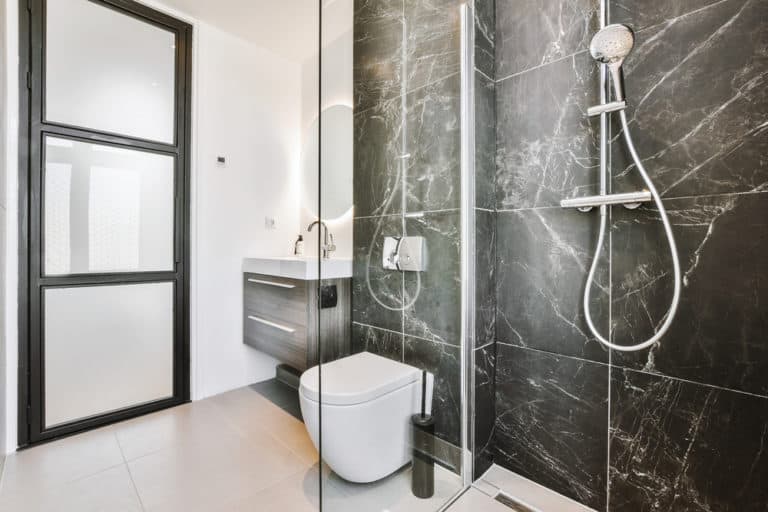Should Countertops Be Lighter Or Darker Than Cabinets?
It is said that the kitchen is the heart of the home. Whether the family gathers there at mealtimes, whether it forms part of your living area, or whether it’s an area you prefer not to use any more than necessary depends largely on how visually appealing it is. Cabinets and countertops can be the deciding factor.
Should countertops be lighter or darker than cabinets? If the kitchen is small, dark, or both, lighter countertops will brighten it up and make it appear larger. But if you’re looking for elegance in a light, spacious kitchen, darker counters are the better choice.
In modern kitchens, much thought goes into the design, the materials used, and overall appearance. Choosing the right combination of colors, the contrasts, the blending with the walls and floor colors, and selecting the best materials to use in that combination is a complex exercise. After looking at the options, there are no rights and wrongs, just personal choices to be made.
Which To Choose First – Countertops Or Cabinets
Before deciding on colors and finishes, you will need to decide whether your cabinets or countertops are the most important feature of your kitchen. Which one do you select first?
Choosing Cabinets Before Countertops
The rule of thumb is that you first select your cabinetry, as it is the dominant surface in the kitchen. The color of the cabinets needs to tie in with the floor and with your kitchen walls, so it is a question of coordinating all three before selecting the countertops.
Choosing Countertops First
There will be situations when the countertops are the “hero” of the kitchen and are considered the most crucial aspect of its visual impact. When there is a special effect created by the counters, and you’ve already set your heart on it, the cabinets are chosen second, and splash back tiles are the last choice to be made.
Select The Countertop Material Before Deciding Light Or Dark
There is a wide choice of materials used in the manufacture of countertops, each with its own properties, advantages, and disadvantages. So before deciding which shade to go with, make sure you’ve chosen the correct type of counter for your lifestyle:
- Granite is the most popular choice, as it comes in a range of colors, including white and black. Very hard-wearing, granite remains beautiful if cared for but can crack or chip and can also absorb liquids and stains. Like all natural stone, granite will need to be sealed every few years.
- Engineered stone is becoming more popular and is available in more colors than natural stone. It is also more durable, less likely to stain, and costs no more than granite.
- Concrete is becoming more popular with its industrial look and is available in different finishes, including polished, giving a shiny surface, or honed, which has a softer, matt appearance.
- Solid surface counters are made of acrylic or polyester resins mixed with a filler such as bauxite. Extremely hard-wearing, heat- and stain-resistant, solid surface counters are available in a wide range of colors and are a less expensive alternative to natural stone.
- Stainless Steel is another practical countertop material, in keeping with the industrial look that is popular in modern architecture. Prone to scratching and even denting, but not difficult to maintain.
- Wood is a warm, characterful material but is prone to damage. It can be scorched by hot pans, scratched and scored by knives, or warped by excess liquid spills. This can be prevented by regular sanding and sealing, but maintenance is unavoidable. Colors are limited to what stains are available and are primarily dark.
- Laminate countertops are available in every color imaginable, with various surface finishes, and are the least expensive material for counters. However, they can scorch and scratch more easily, so they require careful handling if they are to remain looking good.
Bear in mind that these materials, and others, including glass, marble, and travertine, can be mixed and matched. It’s not a rule that all counters in your kitchen must be the same, and you can, for example, have a built-in wooden cutting board on your granite counter or have a granite counter on your island while using engineered stone on the other cabinets.
Choosing light Countertops
The trend in modern kitchens is towards light countertops, in line with newer homes’ brighter, sunnier interiors.
Advantages Of Light Countertops
- They have a crisper, cleaner look which highlights their shape and form
- With a light floor, it can give a beach house look to your kitchen
- They will make a small, dark kitchen appear larger and brighter
- They don’t show surface dust as much as dark counters -less cleaning required!
Disadvantages of light countertops
- They show up spills and stains more than dark counters
- They may give a bland look to the kitchen, especially when the floor and walls are also light
- They are less elegant than dark counters, even if more modern
Choosing Dark Countertops
In a large kitchen and in a more traditional home, dark counters provide a sleek elegance that is not possible with lighter colors.
Advantages Of Dark Counters
- They lend an air of solid quality and a certain luxury to the kitchen
- In bigger kitchens, they highlight the shapes and colors of lighter walls and cabinets
- They don’t stain as much as lighter counters
Disadvantages Of Dark Counters
- They show every speck of dust, as well as fingerprints and watermarks
- They are not suitable for smaller, poorly lit kitchens
Having considered the pros and cons of light and dark countertops and selected what you would like them made of, you’ve been able to narrow your choice down, or maybe even selected the exact countertop you’re going to use. Now it’s time to choose your cabinets.

Select The Cabinet Material Before Deciding Light Or Dark
The choice of material for kitchen cabinets is more limited than for countertops, so the decision is probably easier. The design of the cabinets is a far more complex issue, but that could be the subject of another article.
- Natural wood is by far the most popular choice. It’s one of the most expensive materials, but it’s valued for its durability and unique richness. Colors range from near-white to near-black, with reds, browns, greys, and greens in the color spectrum. Because it’s natural, every piece of wood presents unique patterns and grains. Popular woods include white oak, red oak, maple, ash, beech, and walnut. The disadvantage of wood cabinets is that they are expensive, heavy, and may warp over time.
- Composite wood, including laminated plywood, Medium-density fibreboard (MDF), and particle board, are cheaper alternatives to solid wood. They are sturdy and easy to work with and are available in different grades suitable for specific usages, such as shelving, and partitioning, as well as for fronts and doors. Depending on the surface, it may be possible to paint them the color of your choice.
- Metal, in particular stainless steel, is not very popular, but it is an excellent choice for industrial-style kitchens in modern homes. Obviously very durable, stainless steel is stain-free but does scratch and dent and shows smudges and fingerprints more than other surfaces.
- Laminates are wood particle boards with a laminate made from compressed paper and resins with a wood veneer. Surprisingly durable laminates are used for flooring as well as cabinets and are very much in favor with budget-conscious kitchen designers.
- Melamine is also a paper-based coating over particle board, usually paired with a wood veneer for additional strength. Very popular as a low-cost, durable material, melamine has the advantage of being available in a multitude of colors.
The Advantages Of Light Cabinets In The Kitchen
Every kitchen is unique in some way – the design, the amount of natural light it enjoys, its position in the floor plan of the house, and how important it is in the life of the family. And as a result, choices between light and dark differ as well.
- Light cabinets open up dark spaces and make small kitchens appear larger
- Lighter colors have a more casual and welcoming feel
- Colors get outdated, whereas white cabinetry will always be in fashion
- Light colors don’t show dust and fingerprints as much as darker colors
Disadvantages Of Lighter Cabinets
- Light cabinets will show dirt more easily (for example, around door handles) and show up scrapes, scratches, and dents more than dark colors.
- If floors and walls are also light, the lack of contrast can be bland and unappealing.
- Light cabinets don’t have the same elegance as dark ones.
Advantages Of Dark Cabinets In The Kitchen
- Dark cabinetry in a large kitchen adds sophisticated elegance to the room
- Marks, spills, and minor blemishes tend to be less visible on a darker surface
- Dark cabinets, particularly wooden ones, are well suited to larger, more luxurious homes
Disadvantages of Dark Cabinets
- They make a small kitchen look even smaller unless there’s excellent light.
- Dark cabinets, with their more formal look, might not be appropriate adjoining an informal living space such as a family room.
- It’s more challenging to introduce color into a kitchen with dark cabinets.
Deciding Between Combinations Of Cabinets and Countertops
Given two variables (light and dark) and two components, we have four possible combinations to consider:
- Light counters, darker cabinets – it seems that this is the trend being followed by many kitchen planners. Light counters are easy to clean, even if they require it more often, and combine well with darker cabinets, even in smaller kitchens. Remember that the cabinets can be just a few shades darker than the countertop to create an attractive contrast between the two.
- Light counter, light cabinets – the extreme example of this would be white cabinets with white countertops. It works really well, allowing color and contrast to be introduced in the splashbacks and accessories such as door and drawer handles, light fittings, and décor items.
- Dark counters, light cabinets – think again of the one extreme, white cabinetry with black granite countertops, or light oak cabinets with a darker brown granite or Caesarstone countertop as a more subdued combination. Both could be an eye-catching feature in any kitchen.
- Dark counters, dark cabinets – definitely not for small kitchens, but a dramatic effect in a large, well-lit one. Edgy, classy, and an absolute winning combination when coupled with a lighter floor.
The Importance Of Walls, Splashbacks, And Floors
No decision can be taken regarding the combinations we’ve mentioned above without considering the contrast and compatibility between cabinets and countertops on the one hand and floors and walls on the other.
If you’re redesigning an old kitchen changing the color of the kitchen walls should present no problem and very little expense. If your kitchen is open-plan to a living area, the wall color of both areas should be the same to emphasize space, or at least the two areas must be in tones of the same color.
The wall color must also complement the countertops, emphasizing their color rather than distracting from it and also highlighting the cabinetry.
The floors may present more of a problem if you remodel an existing kitchen, as replacement may prove an expensive exercise. Suppose you’ve changed the layout of the cabinets. In that case, it may be unavoidable to redo the floor. One could consider laminate flooring, new-generation vinyl flooring, or tiles as a less expensive option than hardwood.
Again, color choices to tie the floor into the combination you’ve decided on for countertops and cabinets will make or break the visual impact of the kitchen.
Conclusion
Should countertops be lighter than cabinets? Yes, if you’re following present trends in kitchen design. Certainly, it’s a safe option, and bearing in mind that the contrast between the two elements doesn’t have to be extreme, there is a multitude of options, both in colors and material, to consider.
However, if you consider the kitchen’s size, the style of the house, and the amount of sunlight that the kitchen enjoys, you are perfectly justified in choosing a different combination. There are no absolute wrongs or rights, and if the new kitchen is a beautiful room to look at and work in, you will have made the right choice.
References
- https://marble.com/articles/light-or-dark-countertops-what-is-right-for-you-
- https://www.homedecorchat.com/should-your-countertop-be-lighter-or-darker-than-your-cabinets/
- https://www.hgtv.com/design/rooms/kitchens/choosing-the-right-kitchen-countertops
- https://marble.com/articles/light-or-dark-countertops-what-is-right-for-you-







